Search Google for terms like, “blog marketing,” “increase blog traffic,” or “grow your blog,” and you’ll get a big list of hundreds of blog promotion techniques.
Not that there is anything wrong with such a list. But when going through it, you may feel that every blog marketing method is equally effective. And this is so not the case.
Most of the A-list blogs drive traffic from just a few primary channels. The secondary tactics can work too, but only when the primary are well established.
So in this comprehensive guide, I’ll delve into the most effective strategies designed to amplify your blog’s reach and engagement.
Disclaimer: If you buy any products through links on this site, I may earn a commission. But it doesn't make any difference to your cost, and it helps me keep this blog running. So you could always read my articles for free.
Blog marketing strategies
Whether you’re a seasoned blogger seeking to revitalize your approach or a novice looking to make an impact, get ready for the blog marketing tools and insights necessary to navigate the dynamic world of blog marketing.
Build an email list
What could be better than marketing your blog content to thousands of people quickly? When you have an established audience, you can do that.
And what does it mean to build an audience? It means getting people to follow you in some way. For example, they can subscribe to your blog via email, or join your email newsletter. So whenever you publish new content on your blog, they’ll get notified.
There are other ways to build an audience too, such as asking people to follow you on Facebook, Instagram, or LinkedIn. Or to build a following on Medium or Quora. But it’s better to build an email list instead.
That’s because when you rely on other platforms like LinkedIn or YouTube, you’re at their mercy. You don’t have full control over reaching your audience.
If a 3rd-party platform decides to shut you down or limit the reach of your blog content, there’s nothing you can do. And all the years you spent building an audience on the platform will go to waste.
On the other hand, you have full ownership and control over your email list. You can reach the people on your list as long as you have their consent. There is no middleman.
So how do you get people to join your email list? By providing them an incentive to subscribe. This incentive could be a free trial, a PDF of your blog post, an email course, a white paper, or a useful cheat sheet or template.
In fact, the incentive (also known as a lead magnet) doesn’t have to be anything fancy. You can simply offer free updates about future blog posts via email.
Take Justin Welsh, for example. He just promises to share more of his content via email, and he has more than 200K newsletter subscribers.

There are many online tools that can help with creating popups, landing pages, forms, and calls to action that you can embed into your blog to start building your email list. These include:
Mailchimp – A complete marketing automation platform you can use to capture and store email addresses with unlimited sign-up forms.
Rafflecopter – A tool you can use to launch giveaways and contests to entice people and get them to sign up for your email list.
OptinMonster – A popular lead generation tool you can use to embed different types of popups in different areas of your blog.
Update others’ blog posts
Updating your blog content on a regular basis is one of the best ways to maintain and even improve your search engine rankings. So you keep the traffic flowing to promote your blog content.
But it takes a lot of effort and resources to keep updating your previous blog posts. It’s a challenge for not just you, but also for other companies and people who have a blog.
That’s why you can get in their good books by offering to take off a small chunk of their content management workload. When you notice that someone’s blog post is outdated, why not reach out and offer to update it?
Here’s a template you can use:
“Hi Andy, I recently stumbled upon your blog post about X. I noticed that organic traffic to this post has declined considerably this year. This problem can be fixed with an update.
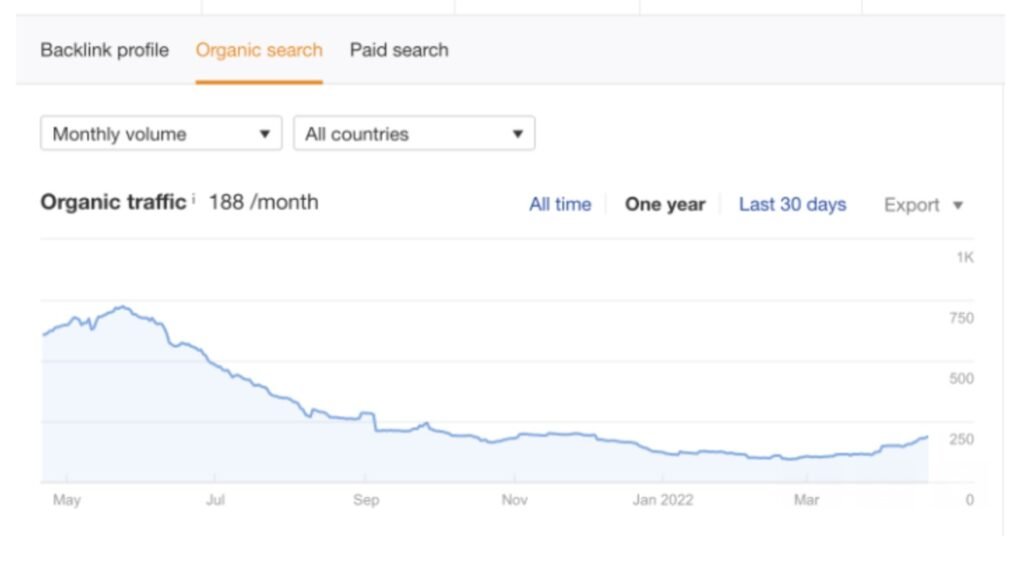
It is important to update older content, as it helps boost search traffic. I see you last updated the post in 2019. A lot has changed since then. For example, the tools you mention have changed their pricing and features.
I’d be happy to help update this content. And optimize it further with Surfer SEO. What do you think?”
Why does this benefit you? Because, just like guest posting, you can use this opportunity to link to your own content as part of the update. Consequently, you’ll increase traffic to your blog.
In fact, this blog marketing strategy is even better than guest blogging. Guest posting often requires you to do a lot of groundwork to come up with topics that your target blog will be interested in. But with updating old posts, there is no guesswork.
So the next question is, how do you find old blog posts of other websites in your niche, the posts that are declining in traffic?
One way is to use the Ahrefs’ Content Explorer. Type in your topic and choose the last year in the Trends dropdown. You’ll be presented with a list of blog posts along with information about their traffic performance.
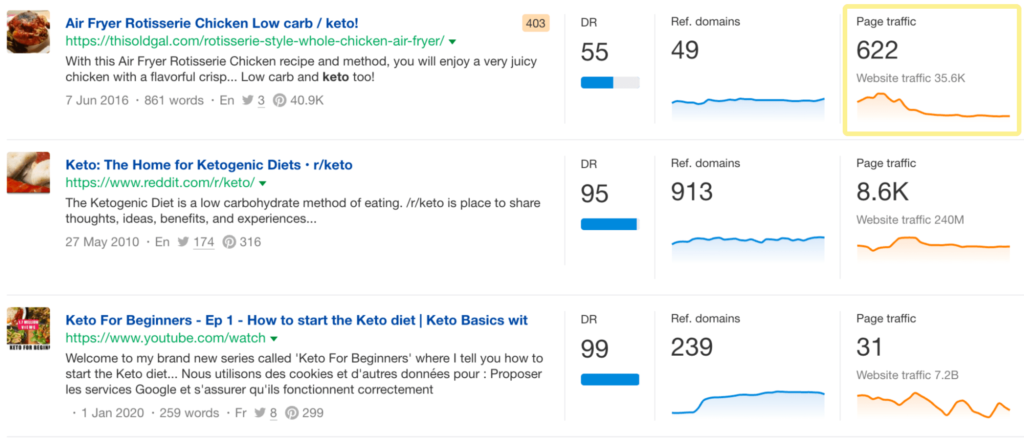
When you see a blog post with decreasing traffic, you can click to view more details. Then, it’s time to contact the editor with your pitch.
Related: Ahrefs review: is it the best SEO software?
Target easy-to-rank keywords
For most blogs, search engines are the biggest source of traffic. You need people to be able to find you when they search Google for keywords related to your blog.
But if you’re just starting in a competitive niche, many of your target keywords may be too difficult to rank for.
To start ranking and getting traffic as soon as possible, you need the low-hanging fruit. In other words, you need to identify the keywords for which you can easily rank in blog marketing.
There are two ways to identify such keywords to grow your blog. One is to use a well-known keyword research tool and enter your seed keyword.
You’ll get a list of related keywords with their search volumes and SEO difficulty scores. From there, you can choose the keywords that are relevant to your blog and that have a low difficulty score.
Another way is to use the Ahrefs’ Content Explorer. Enter your topic and set a Referring domains filter to max. 10. Then add a Page traffic filter to min. 500. Finally, add a Domain Rating filter to max. 30
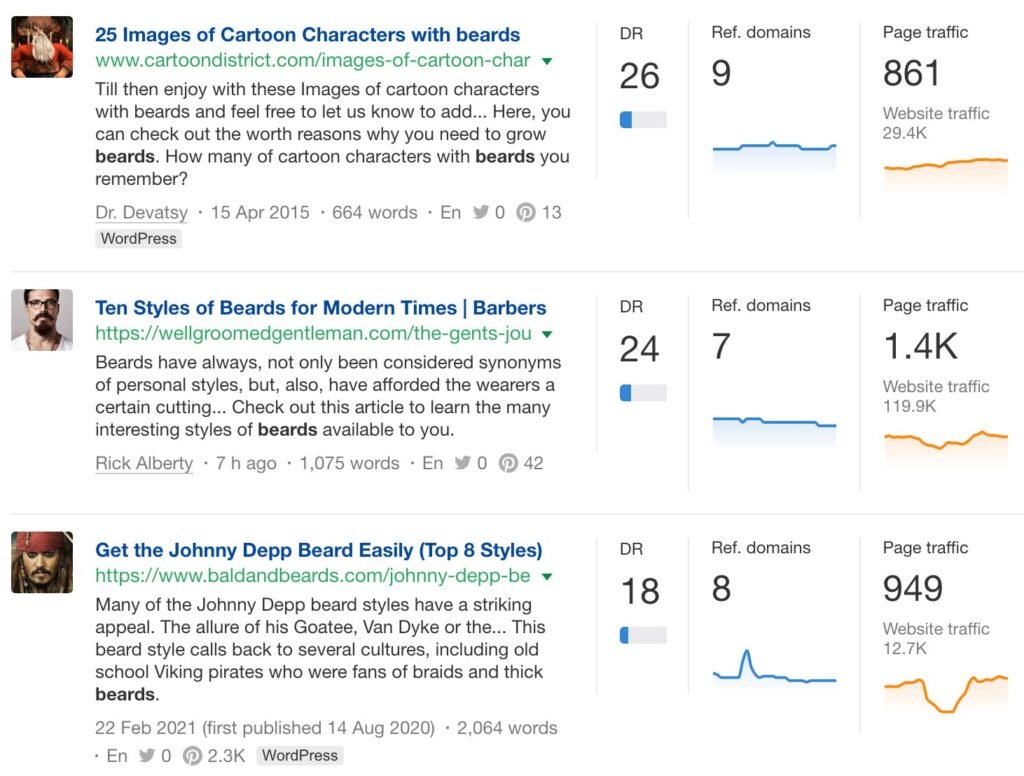
This will show you pages and topics that are getting plenty of search traffic despite not having many backlinks. And that means those topics are easy to rank for.
If you want specific keywords to target, you can click on any topic and then head over to the Organic keywords tab.
Run PPC advertising
Many articles claim to provide you with free ways to grow your blog. But in reality, there is no such thing as free. Even if you’re not paying cash, you’re still spending time and effort on blog promotion. And both are no less than money.
That means if you can find the budget for blog advertising, you’ll be able to save precious time. And you can use that time for other blog promotion strategies.
The most popular online advertising model is PPC (pay-per-click) advertising. In this type of advertising, you pick a target audience to whom your ads are shown. And you are charged a fee every time someone clicks on your ad.

You can buy PPC advertising on various channels. These include Google, Facebook, Twitter, LinkedIn, Instagram, Pinterest, TikTok, YouTube, and more.
The best part about PPC advertising is real-time analytics. You can set up campaigns quickly and start getting data on how your ads are performing. You can use this data to learn what’s working and what’s not working fast.
Then you can make changes to improve your ads further and reach more people at a lower cost. This gives you ample opportunity to get the best return on your ad spend and increase blog traffic.
There is a downside, though. The results you get from PPC advertising are very fickle, especially when compared to SEO. You get traffic only as long as you’re paying, and it dries up instantly when you stop the payments.
So if you’re going to spend all that money to get traffic, it may be better to direct that traffic to a landing page that captures visitors’ email addresses. This way, you can build an email list as discussed above and have repeat access to those visitors.
Write comprehensive blog posts
Before you start blog marketing, you should have kickass blog content. That means writing blog posts that provide detailed answers to your audience’s problems. The more in-depth content you create, the better it will perform.
In fact, a study of bloggers by Andy Crestodina found that bloggers who publish longer articles get stronger results. In fact, the average blog post has become longer over the years.
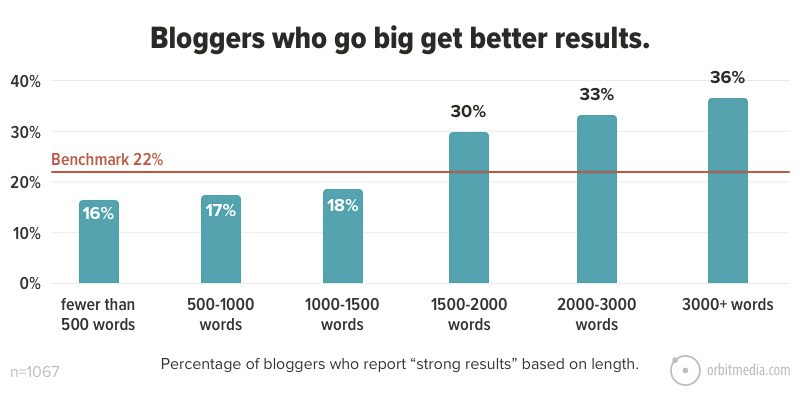
Now, it doesn’t mean that just because a post has more words, it will engage readers. The idea is to provide more value, not add filler content.
Your blog post doesn’t need to be long just for the sake of it. Rather, it should focus on giving readers what they want.
Publish a full post on Reddit
Reddit is one of the most popular websites online. It lets people create, join, and participate in communities. And it has thousands of these communities around different interests and topics. These communities are also called subreddits.
The subreddits that cater to your target audience can be a great place to promote your blog content. But it’s not as simple as joining a subreddit and just dropping your link in front of users.
Reddit users are notorious for penalizing posts which are nothing but blatant self-promotion. Worst-case scenario, you can even get banned from the community for shameless blog marketing.
That being said, Redditors do appreciate useful content that’s shared directly on the platform. How can you leverage this?
You can reduce the blog post you want to promote to bare bones by removing images, links, or other formatting. Then, share this version in your Reddit community.
Here’s what you’re doing: instead of asking users to click on the blog post link to read the entire post, you’re showing them your content right there. Below the content, you can drop in your link for people who want to see the full-fledged post.
When you do things this way, you’re less likely to piss people off and more likely to increase traffic to your blog post.
Match your blog content with search intent
As I said before, search traffic is the best kind of traffic you can aim for, especially when it comes to blog marketing. It is stable, compounding, affordable, and relevant.
Now, to get this traffic, you already know that you should write blog posts that target keywords people are searching for. The process of finding these keywords is called keyword research.
But just inserting your target keyword throughout a blog post is not enough. You also need to make sure that your blog post matches the keyword’s search intent.
In other words, you want to understand why a searcher is searching for that keyword. What do they expect to get from their search? This expectation they have is known as search intent.
Now, how do you know the search intent for a given keyword? That’s where Google can help. The search engine has been processing billions of search queries over the years and has enough data to determine what people want when they search for a particular phrase.
So Google uses this data to populate the top-ranking results when someone searches for a keyword. Since these results are publicly available, you can use them too. Just search Google for your target keyword and look at the top-ranking pages. Then, ask yourself the following questions:
What type of content is ranking at the top?
Is it a product page, blog post, category page, video, or landing page? For example, a search for the keyword “how to write a book” yields mostly blog posts. So you know that most people who search for this query want to read a blog post.
On the other hand, a search for “how to ski” will generate videos as the top-ranking content.
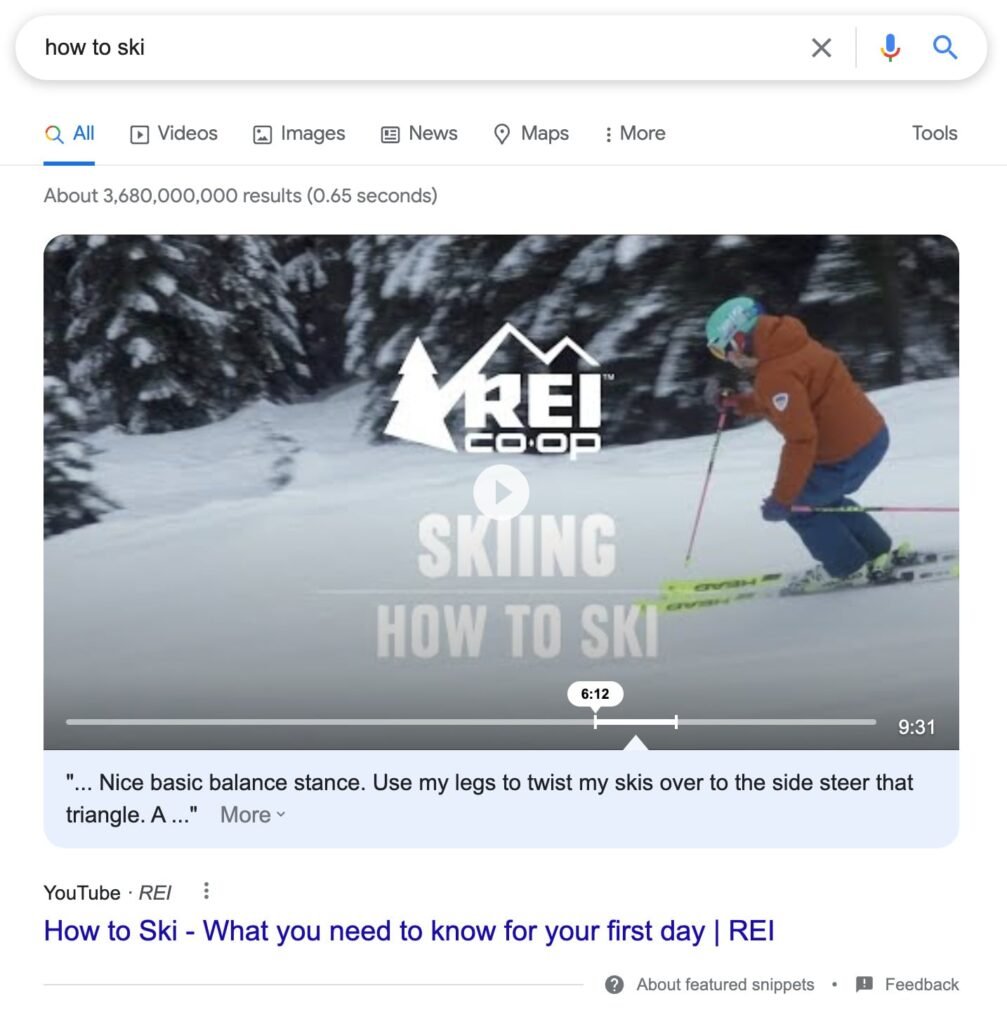
So you can assume that a blog post will not be the best way to rank for this keyword. You’ll need to make a video instead.
What’s the format of top-ranking pages?
This means the layout associated with top-ranking pages. For example, are they mostly guides starting with “how to,” listicles starting with “top 10,” product reviews, opinion pieces, or something else?
For example, if your target keyword is “personal finance,” you can write a blog post on this topic from many possible angles. These include:
- What is personal finance? (question)
- How to manage personal finance? (guide)
- Personal finance tools (list)
- Personal finance strategies or tips (list)
- Why personal finance is important? (question)
- And many more
But to identify what angle is more likely to rank at the top, it’s wise to check what’s already ranking at the top. If you search for this keyword and see that most of the top-ranking articles are personal finance guides, then that’s what you should write too.
What’s the content angle?
This refers to the key benefit or value proposition of the top-ranking content. For example, if you search for “how to make money,” you’ll see that most of the top-ranking pages are about how to make money “online,” not just how to make money in general.
Build backlinks
As you can see by now, the majority of blog marketing strategies in this post have focused on SEO. That’s because it’s the topmost source of traffic for most blogs. And the most important component of SEO is building backlinks.
What’s a backlink? It’s a link embedded in another blog or website that points to a page or post on your blog. Each such link is seen as a vote of confidence in your blog’s value and trustworthiness.
The more backlinks you get from other websites, the better rankings your blog content will get in search engine result pages. Even better if those links are from high-authority websites. This will boost your perceived value even more in the eyes of Google.
Now, in the past, getting backlinks was fairly easy. All you had to do was write great content and leverage a few industry connections. But these days, digital marketing is very competitive.
If you want to earn backlinks and grow your blog, you’ll need to proactively reach out to people and ask for them. And even then, you’ll have to offer some kind of incentive to encourage website owners/editors to link to you. There are many ways to do this, such as:
Broken link building: You find dead links in someone’s blog post and offer a better replacement. And that replacement is a link to one of your blog posts.
Guest blogging: You offer to write a post for a blog for free, and get a backlink in exchange.
Claim unlinked mentions: In this case, you find webpages that have already mentioned your personal brand name or business name but haven’t linked to your website. Then, you ask the people who manage those web pages to link to you.
There are hundreds of different ways to build backlinks. You can learn them here and see which ones are best suited for your blog and industry.
Final thoughts on blog marketing
Blog marketing is not just about promoting stuff anymore; it’s about creating real connections with people and expanding your brand in exciting ways.
By crafting cool content, knowing your audience, and using social media wisely, you can make your blog a powerhouse for your business.
It’s all about telling your story authentically and making friends along the way. So, if you want to rock the digital scene and make a lasting impression, give the above strategies a whirl and see how it goes.
Did I miss anything? Did you try these tips? Do you have any questions or comments? Share your thoughts below in the comments section.



Implementing these tips can truly elevate a blog’s reach and engagement. High-quality content remains the backbone of successful blogging, and investing in Content Writing Services in Delhi can ensure well-researched, engaging, and SEO-friendly articles that drive traffic and conversions. Looking forward to more valuable content!